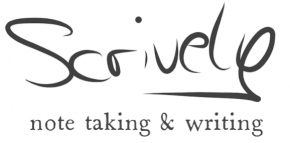As I am always on the lookout for meaningful ways of bringing the best parts of analogue and digital writing and note-taking together, Whitelines is another interesting product that I stumbled upon lately.
Whitelines is a paper-innovation from Sweden – and the idea is as simple as it is genius: its greyish paper uses white lines (or: white ruling), which is where the name’s derived from, instead of the conventional dark ruling on regular white paper. How that shall help, you ask? Let’s look into things.
The theory
First of all: What does this Whitelines-paper actually look like? This question is probably easiest to answer. And I will answer it with just a simple photo. It looks like this:

Next, and according to the company, this white-lines-on-grey-background-thing is easy and gentle on the eye, since
the background is tinted in a light grey tone which makes it less tiring for the eye than using a white paper [… because] dark supporting lines have the same contrast as the pen you write with and that creates a conflict in your brain
and
markings from pens are dark they interfere with the traditional dark lines of ordinary paper. On Whitelines there is no visual interference between the lines and the pen colour.
The science sounds good, doesn’t it?

While this sounds great, I personally may have not used the product long enough or a more dark-line-conflict-resistant brain (who knows?!) in order to definitely conclude whether there really is that much of a difference when reading and writing on the Whitelines-paper as opposed to ‘regular’ paper. This is also, since (unlike the example above, which is taken from the company’s website) the ruling of ‘regular’ paper rarely is as pitch black as the one pictured above. Mostly, it is held in dark-grey tones, which I have never really found to be disturbing. But anyway, it is definitely also not uncomfortable to read and write on the Whitelines-paper. So I leave this particular judgement up to each and everyone of you out there – go and find out for yourself.
The second claim, however, that those white lines’
background easily disappears when you copy, scan or fax
is actually much easier to test. And, at least to me, also a much more useful advancement when you regularly digitize notes and sketches. So let us have a look at that and put the paper to test!
The practice
So, first of all, I took some square-ruled Whitelines-paper as well as some regular white paper in dotted ruling that I had at hand, and tainted both of them in a similar fashion with a pencil, some fineliners and highlighters.

Next, I scanned both ‘notes’ with the Genius Scan-App of my mobile phone.

And: the promised magic really happens! Unlike the dotted background of the regular paper, the ruling/background of the white lines-paper disappears completely! Really nice.
To me personally, this might not be a huge benefit for my regular note-taking – but this is entirely because of my preference for plain paper for that purpose and has nothing to do with the product itself. For sketching, however, I do sometimes find supporting ruling pretty helpful, which is where the Whitelines-paper comes in really handy.
If you want to try it out for yourself, you can download and print Whitelines-paper here (A4 and A5, lined and squared, as PDF) for free. If you like it, it can be bought here or here, for example.


